Lens performance - the view from Carl Zeiss
A camera records a subject instantly as the light reaches the film. Any subject may be recorded and thought of as a photograph, but how good must a lens be to make an expressive photograph? When a complicated subject is abstracted to its basic elements we find patterns, colors, texture and contrast exhibited. It is important to relize that a lens, as a transformer, reduces reality from three dimensions to two. The effect is that while the photograph is made from these elements on a plane, a good photograph can evoke an emotional response. It is a very high quality lens that can express this information precisely without adding its own accent. It is said that we need only to rely on a superb lens and a unique point of view to obtain an excellent photograph.
Resolving power
When we make a photograph, the image is made from complicated patterns of light and shadow. These patterns are composed of light and dark image parts. The extremes of these lights and darks are black and white. These are the fundamental contrast components and the data points for measuring resolving power and contrast. The purpose of the photograph is to capture object shapes. The finer the shape that the lens can render, the higher the resolution. Unfortunately experience has taught us that high resolution alone did not always produce the best photograph because the human eye can't seperate lines that fall closer than approximately 10 mm of frequency in the center of clear vision.
When a picture of 24 x 36 (35 mm) is enlarged to 5 x 7 inches, the enlargement magnification is five times. Accordingly, the resolving power on the film requires no more than 50 lines per milimeter. When a big picture is printed by increasing the enlargement magnification, it must be viewed from a greater distant and more resolution may not be required.
High resolution power is useful for high contrast charts (subjects) and the copying of printed materials but it is not as inportant for general photography. In general subjects, texture is expressed by subtle changes in brightness and darkness and a photograph is composed of many variations of these textures forming shapes that make up the entire image.
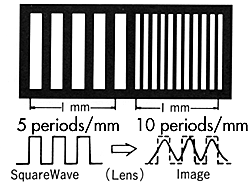 Contrast reproduction
Contrast reproduction
It is desirable that a subject should render on a photograph the equivalent contrast as the scene in reality. A successful black and white photograph should have a pure white highlight area and a pure black shadow area. Contrast reproduction is a measure of how many gradations of intermediate tones occur between the extremes of black and white. This effect is quite different from resolving power.
"MTF" (Modular Transfer Function"
MTF indicates the ability to define the lens, not by resolving power, but by the percentage of what information is collected through the lens against what information exists on the target. In other words, from the original target (subject) what percentage is passed through the lens. In an example, a television image is broadcast from a television studio through an electronic system and the signal is output to your television set. How much detail is lost through the transmission of that signal? That loss is measured as a percentage.
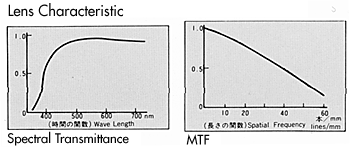
Of the two main measurements, one is spectral transmittance for showing color reproduction, the other is MTF showing delineation performance. The former is the value for light frequency ( a function of time) and the latter is the value for spatial frequency ( a function of length). The striped patterns in black and white, similar to a resolving power chart, are, in reality, a spatial frequency chart, or rectangular wave chart. It is enough to say that general subjects are a combination of various spatial frequencies and amplitude ( contrast). Lens performance is evaluated by measuring contrast ( rate of amplitude decrease) on the focused image field for various spatial frequencies. This is MTF.
When ray tracing a lens design it is possible to determine where any incoming light will emerge from the lens and fall onto the film plane. MTF can be calculated with this data and lens performance can be determined in numerical value with the help of a sophisticated computer program. Before MTF, lens performance could only be foreseen by application of the aberration theory. MTF is so accurate that a protoype trial sample is not required. MTF has contributed greatly to the progress of optical technology.
How to read the lens performance chart
With Carl Zeiss T* lenses, the fundamental data for each individual lens is disclosed. By using this data we can calculate magnification and camera-to-subject distance with extension tubes, bellows or in other special applications. Also, since relative illuminance and distortion are shown, more intelligent lens selection can be made to avoid situations where these limitations can degrade the image.
MTF curve
In a lens having an axis of symmetry ( the light axis) radiating from the center, the image placement is proportionally the same distance, in theory, in the lens, as the focused image field (film plane). That distance from the center of the imagefield is set on the horizontal axis as the image height. The modular transfer factor is set on the vertical axis. The higher the line on the vertical axis, generally speaking, the better the performance of the lens.
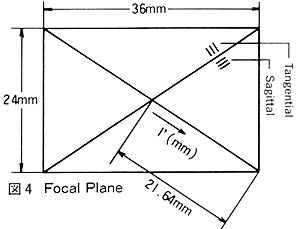
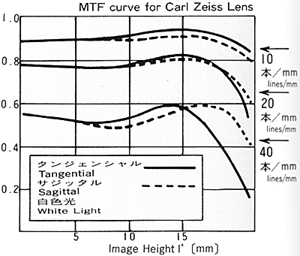
The lens performance must be considered in both sagital and tangential respects. Sagital targets are radical in design as in a black and white pie chart with alternative tones. Tangential can be considered as concentric in orientation. The spatial frequency is marked at 10 periods per milimeter, 20 periods per milimeter and 40 periods per milimeter at the film plane. On MTF chart you will note that the 10, 20 and 40 periods per milimetre lines are drawn across the chart with the sagital measuremnet as a solid line and the tangential line is drawn as dotted. Carl Zeiss supplies MTF measuremets at two different f stops usually wide open at the maximum f stop (theoretically the worst performance) and ususally two stops down from wide open ( theoretically the best f stop). The frequencies of 10 and 20 periods per milimeter indicate the reproduction of contrast in white light from 360nm to 700nm. The 40 periods per milimeter is indicative of the resolution produced by the lens. The character of a lens is shown against the change of the spatial frequency. For instance, a lens where the lines of 10 and 20 periods per milimeter are close, while the 40 periods per milimeter are separated, is said to have high contrast and lower resolution, while a lens that is opposite such as where the 10 and 20 periods per milimeter are separated, while the 40 periods per millimeter are close to the 20 periods per milimeter, is said to be higher in resolution and lower in contrast.
Illumination of the field
The brightness (illumination) of the image field (film plane) is decided by the aperture set on the lens. The light coming through the lens at the edge, or peripherally, is sometimes, interrupted by the lens body and it is natural that all of the light is not transmitted to the image plane, and this is known as aperture efficiency. Also light entering the lens at theta degree to the light axis is deceased on the image field in proportion to the COS4 théta (COS4 Law).
The larger a lens aperture opens, the larger the vignetting becomes. It is obvious that the faster the f stop of a lens is, the vignetting occurs. This effect is an additional complication that must be overcome to provide high speed lenses. Psychologically, a viewer is prepared to accept some light off from the center to the edge.
Distortion
The image formed by a lens should be perfectly similar to the subject. Distortion is the variance on the focal plane from the object in reality. If an object is photographed at distance l from the center of the lens it will fall at l' on the image field and the distortion is shown as;
Distortion = (l'-l) / l
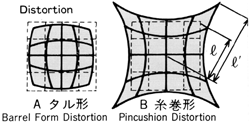 In case the value is - (minus), the image distortion becomes a barrel type. In case where result is + (positive), the distortion is pin-cushion ( a bobbin type). Distortion will only be evident in lines not running through the center of the lens axis.
In case the value is - (minus), the image distortion becomes a barrel type. In case where result is + (positive), the distortion is pin-cushion ( a bobbin type). Distortion will only be evident in lines not running through the center of the lens axis.
Distortion is not a simple comparison of performance to an absolute value, but as the nature of the image field varies, the distortion changes relative to the center of the lens.
Other Lens Performance
The lens is evaluated at each aperture and camera-to-subject distance for factors such as focusing performance, color reproduction, relative illuminance and flare. How good the lens is cannot be determined by measuring one aspect of its performance. Only Carl Zeiss, with over 150 years of optical experience and tradition, can assure the highest performance of every lens.
Color reproduction (Spectral transmittance)
Color transmittance of a lens is an important factor in determining lens quality along with resolution and contrast measurement. Every Carl Zeiss T* lens has the same spectral transmittance and the color does not change even if the lens itself changes. It is a closely held trade secret how Carl Zeiss accomplishes this task. The T* coating is applied in Japan to the Carl Zeiss lenses by prescription generated in Oberkochen, Germany. This coating material is sent from Germany to be applied to each lens as it is produced.
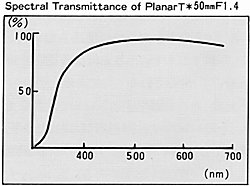 A lens is inspected and assembled under standards that dictate the spectral transmittance of each surface of each lens element from 360nm to 700nm corresponding to the range of visible light. Then the overall transmittance of the assembled lens is tested again, and this measurement must meet the specifications generated in Germany for each production batch. There is no difference between a Japanese manufactured lens and a German lens. Any other manufacturer would say it is impossible to assemble a lens from different types of glass having different spectral responses and then correcting this mixture by varying the coatings to obtain a uniform result.Carl Zeiss does this continually on a production basis. No other optical manufacturer in the world is capable of this performance.
A lens is inspected and assembled under standards that dictate the spectral transmittance of each surface of each lens element from 360nm to 700nm corresponding to the range of visible light. Then the overall transmittance of the assembled lens is tested again, and this measurement must meet the specifications generated in Germany for each production batch. There is no difference between a Japanese manufactured lens and a German lens. Any other manufacturer would say it is impossible to assemble a lens from different types of glass having different spectral responses and then correcting this mixture by varying the coatings to obtain a uniform result.Carl Zeiss does this continually on a production basis. No other optical manufacturer in the world is capable of this performance.
Flare (Ghost Imaging)
Flare can be thought of as noise in the light signal through the lens. The effect is to cause overall degredation of contrast over the entire image as well as bright images of the diaphragm recorded on the film.
In lens design, performance may be enhanced by adding elements to solve specific optical problems. The downside of adding elements is that the number of air-to-glass surfaces increases, and with this increase, higher amounts of light are lost to flare.
For example, a lens with six elements in five groups has ten air-to-glass surfaces and if we assume a spectral transmittance in each element of 96% (4% reflection), the light coming through those ten surfaces becomes 66,5% and more than 1/3 of the light passing presenting itself to the lens is reflected instead of transmitted to the film plane as an image. Some of this reflected 1/3 will reach the film but when it does it will not be image forming but flare. The reflection percentage varies widely with the index of refraction of the glass element, the wavelength of light and the coating it encounters. When this reflected light reflects again it is usually in the range of 0,15% and this reflection covers the entire film plane. While this is a serious problem it is eclipsed by reflected light that is so strong and it creates its own image in the shape of the lens diaphragm. The number of these images can be as high as 45 with a 10 faced lens and 66 times with a 12 surfaced lens. Light coming into the lens can include sources outside the angle of view such as the sun, and this can cause serious degradation of the image through ghosting. The ghost image, again, is in the shape of the diaphragm and it runs from the center of the lens back to the position of the light source. In addition to the diaphragm image the overall quality of the image is degraded by this reflected light. With the application of multi-coatings, this reflection percentage is reduced to the area of 0,5% per surface. In the case of the six elements lens with five groups, the spectral transmittance comes to 95.1% with those ten surfaces. Even with twelve surfaces it comes to 94.2%. The reflection rate of reflections comes to just 0.0025% and performance over the entire field is improved. Unfortunately, even with this small amount of reflection ghost imaging may still occur.
Carl Zeiss T* anti-reflection coatings are effective across a wide amplitude of light waves. Flare or ghost imaging has been reduced lower than any other optical system but still there is a chance that ghost imaging can occur especially in some orientations to the sun.
Add your message
Please login here or if you've not registered, you can register here. Registering is safe, quick and free.
photodo Stats
428 MTF tests
74 in-depth photodo reviews
100+ users join each day
Help the lens community by reviewing or rating a lens today via our lens search
Latest Lens Reviews
- Chinon 28mm f/2.8 Vintage Lens Review
- Canon EF 70-200mm f/4L IS II USM Lens Review
- Samyang AF 85mm f/1.4 EF Review
- Sigma 70mm f/2.8 DG Macro Art Review
- Samyang AF 24mm f/2.8 FE Review
- Meike 50mm f/1.7 Review
- Tamron 70-210mm f/4 Di VC USD Review
- Lensbaby Burnside 35mm f/2.8 Review
- Asahi Super Takumar 50mm f/1.4 Review
- Asahi Super-Multi-Coated Takumar 135mm f/3.5 Review
